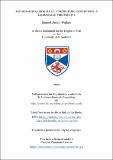Files in this item
Mathematical models of atmospheric convection : a Lagrangian perspective
Item metadata
| dc.contributor.advisor | Dritschel, David Gerard | |
| dc.contributor.advisor | Scott, Richard Kirkness | |
| dc.contributor.advisor | Stirling, Alison | |
| dc.contributor.author | Wallace, Samuel Joseph | |
| dc.coverage.spatial | 226 | en_US |
| dc.date.accessioned | 2023-05-29T15:44:34Z | |
| dc.date.available | 2023-05-29T15:44:34Z | |
| dc.date.issued | 2023-06-13 | |
| dc.identifier.uri | https://hdl.handle.net/10023/27696 | |
| dc.description.abstract | This thesis presents extensions and enhancements to an existing Lagrangian model for atmospheric convection. The Moist Parcel-In-Cell (MPIC) method, developed by Dritschel et al. (2018), is a novel approach which avoids some shortcomings of conventional large-eddy simulation models, particularly concerning the representation of sub-grid turbulence. While the method is in a relatively early stage, we provide case studies to show the model’s potential. The first case study simulates the ascent of a rising thermal, subject to constant vertical wind shear. Using MPIC, we find that low to intermediate shear appears to promote cloud growth, but high shear tears the thermal apart. The air is partitioned into cloud-air and dry-air components based on the liquid water content and the evolution of the enstrophy associated with each component suggests that the increasing shear is causing more dry air to become turbulent and influence the growth of the cloud. Our second study analyses the potential energy in MPIC and its sensitivity to numerical parameters. The results show an abnormal growth in the total energy at early times, which is attributed to a failure to enforce incompressibility in the method. The energy evolutions appear to converge with resolution and the numerical mixing parameters in the model for early to intermediate times, although the turbulent flow leads to greater discrepancies in the late-stage energy evolution. Finally, we present a simulation of the shear-free atmospheric boundary layer, modelled through the implementation of surface fluxes of parcel attributes in MPIC. Our results show evidence of the two-layer entrainment zone structure observed in previous studies. Comparisons of the vertical enstrophy distribution and vorticity field further support this. We also compute entrainment rate parameters that suggest that MPIC underestimates entrainment compared to the zero-order model and overestimates entrainment when using the global buoyancy increment across the entire entrainment zone. Nonetheless, the entrainment rate in MPIC compares favourably to results in the literature when using a local buoyancy increment computed at the height of minimum buoyancy flux. | en_US |
| dc.language.iso | en | en_US |
| dc.rights | Creative Commons Attribution 4.0 International | * |
| dc.rights.uri | http://creativecommons.org/licenses/by/4.0/ | * |
| dc.subject | Convection | en_US |
| dc.subject | Boundary layer | en_US |
| dc.subject | Geophysical fluid dynamics | en_US |
| dc.subject | Vorticity dynamics | en_US |
| dc.subject | Cloud physics | en_US |
| dc.title | Mathematical models of atmospheric convection : a Lagrangian perspective | en_US |
| dc.type | Thesis | en_US |
| dc.contributor.sponsor | Engineering and Physical Sciences Research Council (EPSRC) | en_US |
| dc.type.qualificationlevel | Doctoral | en_US |
| dc.type.qualificationname | PhD Doctor of Philosophy | en_US |
| dc.publisher.institution | The University of St Andrews | en_US |
| dc.identifier.doi | https://doi.org/10.17630/sta/485 | |
| dc.identifier.grantnumber | 1950021 | en_US |
The following licence files are associated with this item:
This item appears in the following Collection(s)
Except where otherwise noted within the work, this item's licence for re-use is described as Creative Commons Attribution 4.0 International
Items in the St Andrews Research Repository are protected by copyright, with all rights reserved, unless otherwise indicated.


